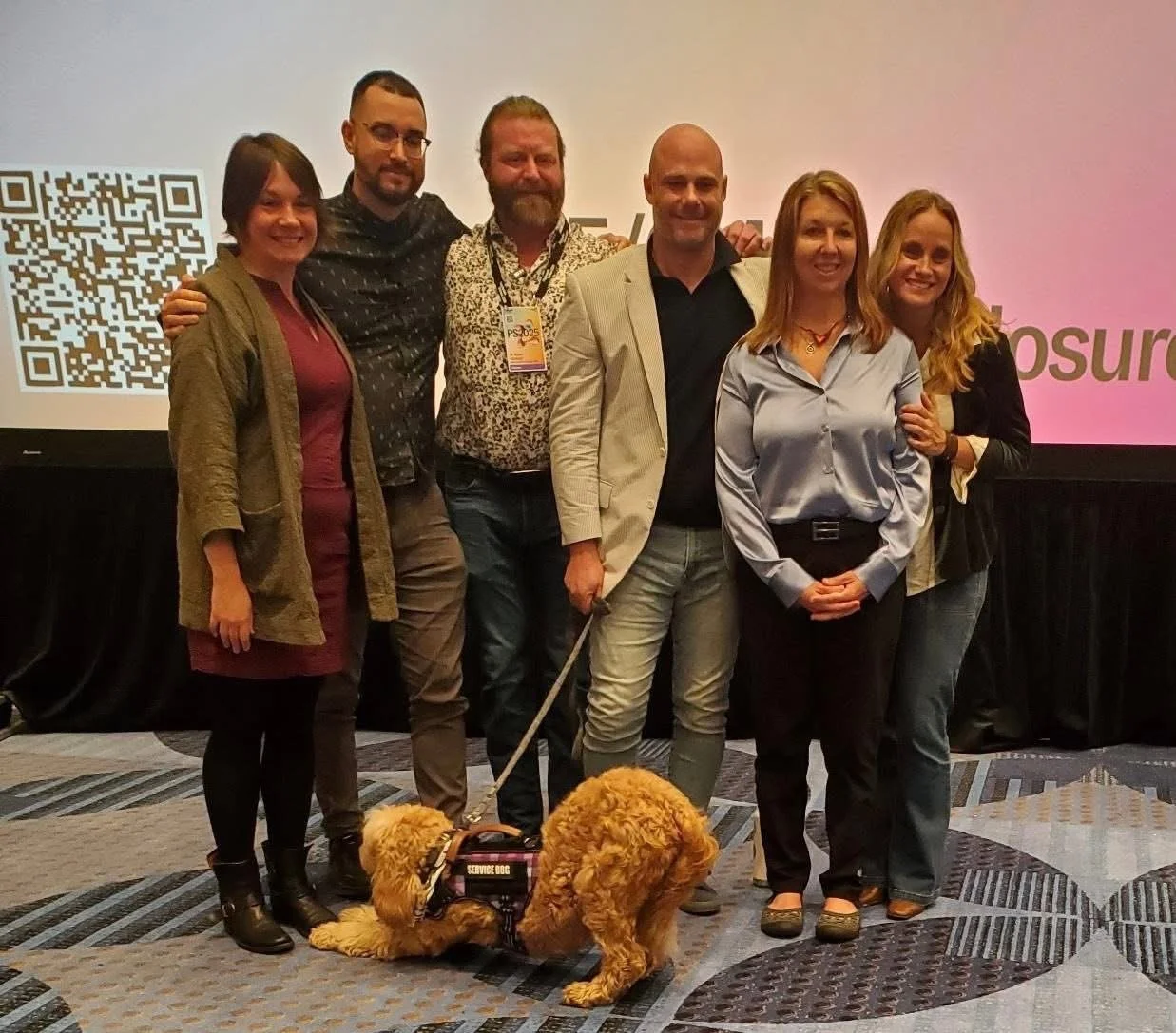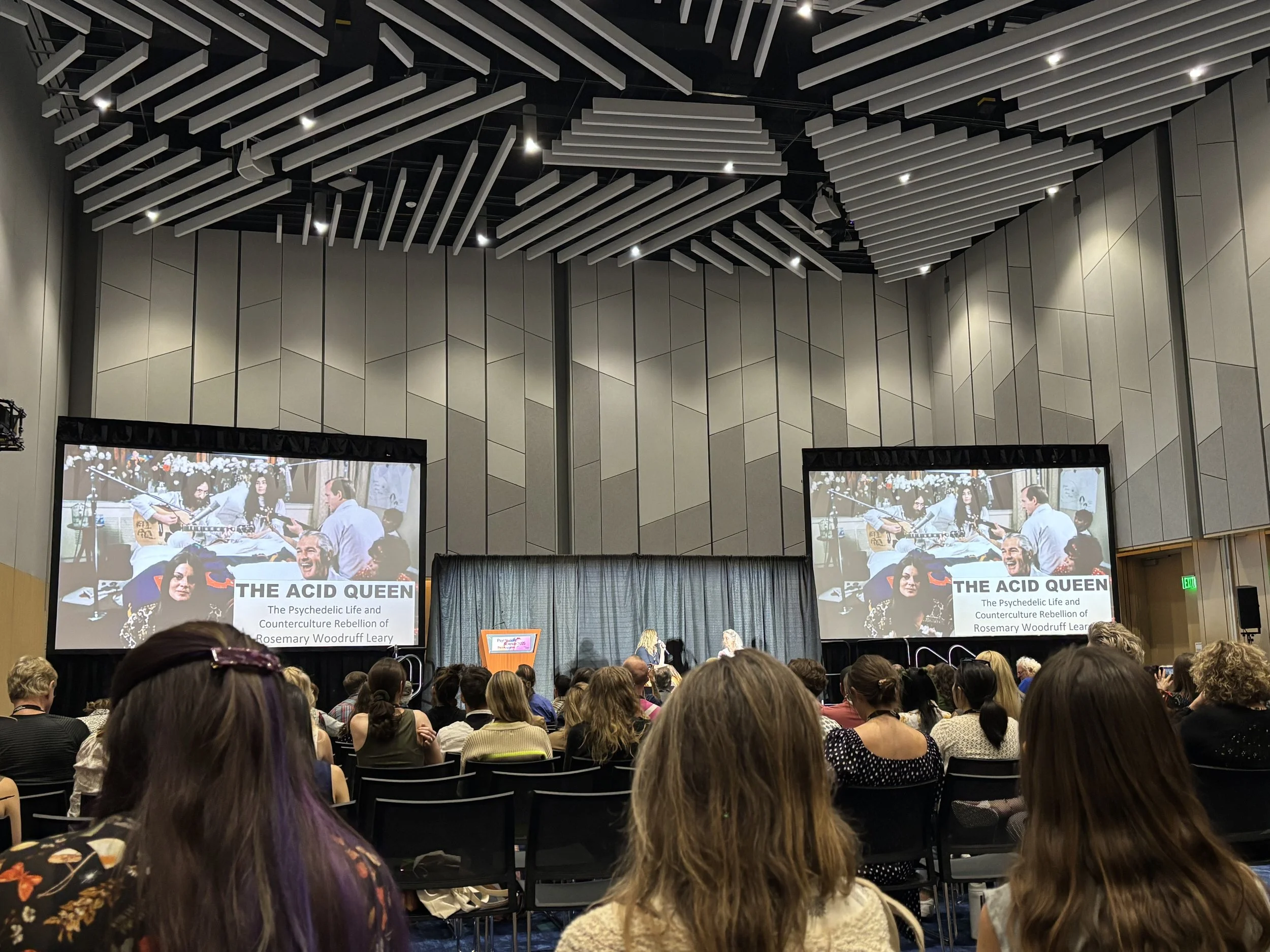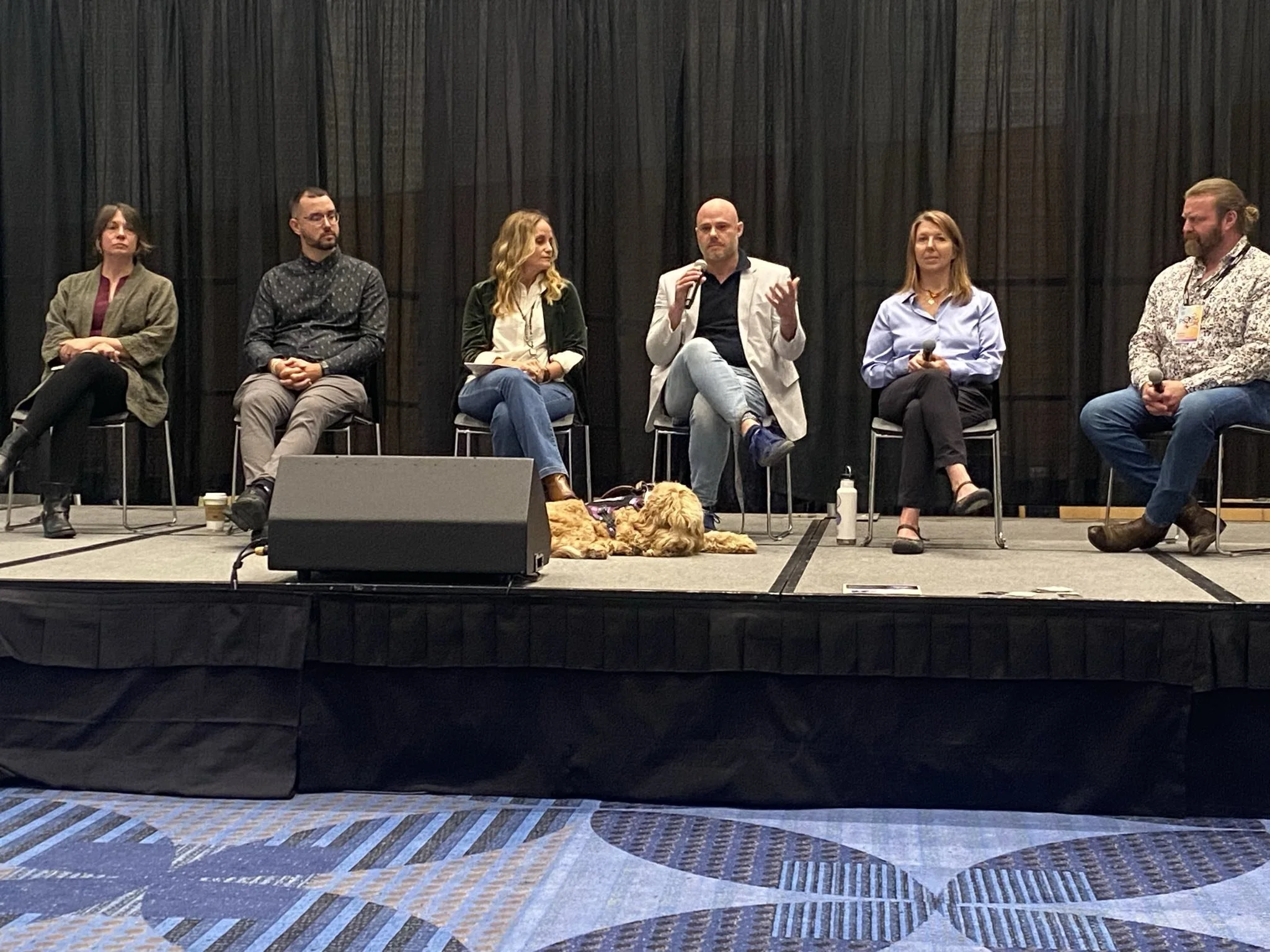Mile-high hollers: APS at Psychedelic Science 2025
Ali and Justin with moderator W. Bryan Hubbard (Americans for Ibogaine) and co-panelists Ben McCauley (Denovo Therapy), Angie Leek (Holos Counseling), and Christina Conrad (Palo Santo Therapy)
If I’ve learned anything from my own psychedelic experiences, it’s to be open to whatever wisdom the journey is bringing me, even if it looks really different from what I was hoping for or expecting. It’s a reason I stopped setting intentions for psychedelic journeys, beyond going in with the prayer that my experience will unfold as it needs to. For me, intention really shows up after the journey has ended, when I’m taking the insights back into my daily life.
The psychedelic movement overall is facing a similar challenge when it comes to intention. In the past year, MDMA was denied FDA approval – though it had been considered such a safe bet that many clinics and training programs built up extensive programs to get people ready for the day it’s available to patients. Post-decision, there has been frustration, scrambling, wringing of hands, and (to use everyone's favorite word) plenty of pivoting.
In the months following the decision, a dark-horse candidate, ibogaine, has gained substantial traction. Just before Psychedelic Science 2025 kicked off, the Texas legislature voted to invest $50 million for research on the compound. Ibogaine doesn’t have the years of highly publicized studies behind it that MDMA has, and it certainly doesn’t have name recognition outside of the psychedelic movement. But that’s about to change. Arizona is including $5 million in public funds (with another $5 million anticipated in private funding) for ibogaine resarch. Closer to home, North Carolina may soon have a state task force that would evaluate psychedelic-assisted therapies, ibogaine among them (and according to former Senator Kyrsten Sinema, who spoke at the conference, Thom Tillis is a supporter).
The last time I was at Psychedelic Science was 2017, when it was held in Oakland. There were over 3,000 people, making it feel large but not overwhelming. I felt like I was part of a growing movement that was still very much on the fringe. For me as someone new to the space, it was like a buffet of science, art, philosophy, religion, and culture with no end in sight. I just wasn’t sure how to talk about it back home in North Carolina.
I didn’t make it to the 2023 conference, which had over 12,000 people in attendance. Controversies bubbled up around issues like the commodification of psychedelics and the Indigenous presence at the conference (those have returned in critiques this year). People vocally questioned the sustainability of the psychedelic movement, its relationship with history, its issues with accessibility and inclusion, and the character and integrity of the figureheads – founders, leaders, teachers – themselves.
Indigenous drumming and song circle in the Colorado Convention Center
What happens when a so-called “bubble” bursts? A combination of the FDA’s decision not to approve MDMA and criticisms of the movement – valid or not, leveraged well or poorly – has shifted the movement’s energy. In the opening plenary, Rick Doblin (wearing his signature conference white, as well as black and blue to represent the metaphorical bruising the movement, and specifically MAPS, has been through) reframed this work as lasting over lifetimes.
I think the slowdown is a good thing. Around 8,000 people attended Psychedelic Science 2025: The Integration. That’s less than 2023, but it’s still plenty, and the Colorado Convention Center in downtown Denver felt busy, though not too crowded. Indigenous leaders and teachers were visibily present – on the plenary stage, at the keynotes, during the Chacruna Sidebar Conversations (set up in a comfortable circle complete with offering area and lounge worthy pillows to the side of the main hallway), and during impromptu invocations, prayers, rituals, and performances peppered throughout the week.
The questions are still hard, though. What do we lose if we focus only on traditional science and research? What happens when we remove these plants and compounds from the geographic areas and peoples that have used them for centuries? What does real Indigenous reciprocity look like? How can we be in right relationship – not only with these plants, but with clients, patients, businesses, cultures, ourselves? Are the multiple narratives and paths forward able to be in dialogue? And why is the conference ticket so expensive?
I don’t have the answers, but I know that it’s important to keep showing up with questions and reflecting perspectives that haven’t been heard as much in the “psychedelic renaissance. There was a lot of that at this conference, and even panelists on the more hardcore science and business-centered conversations brought up the complexities of the field as it related to their work.
I attended a half-day workshop on “Cultivating Inner Alignment, Relational Repair, and Collective Accountability for Psychedelic Business Success.” Far from offering a “get rich quick by founding a psychedelic business” seminar, the masterful facilitators offered us opportunities for deep self-reflection and left us envisioning what an ethical business framework might look like.
A session focused on neurology research illuminated the latest findings on low-dose psilocybin for migraine and cluster headaches, as well as the promising effects of psilocybin on irritable bowel syndrome, phantom limb pain, fibromyalgia, and Parkinson’s. All presenters brought up their goals of broadening their research to more – and more diverse – populations, a critical need in the field.
The panel “From anecdotes to evidence: Mothers advancing psychedelic research and practice,” convened a group of women whose professions and passions ranged from exploring the role of psilocybin in pregnancy and breastfeeding to researchers asking questions about how psychedelics affect hormonal cycles. The central questions: What would research look like if more data were gathered on women? And, an even larger question – what if the evolution of the psychedelic movement included more mothering energy?
From there, I headed to a talk from bestselling investigative journalist and author Susannah Cahalan, who recently debuted her new biography, The Acid Queen: The Psychedelic Life and Counterculture Rebellion of Rosemary Woodruff Leary. The session offered a fascinating, powerful “yin history” of a courageous woman often overshadowed by her controversial, fame-seeking partner.
Susanna Cahalan’s talk on Rosemary Woodruff Leary and her new book, The Acid Queen
I was also proud to represent one of those perspectives – that of Southern Appalachia – on a panel at the conference, “The Heartland Meets Appalachia: Exploring Psychedelic Healing and Regional Resilience.” Moderated by W. Bryan Hubbard (Americans for Ibogaine), the panel featured myself and APS co-founder/CEO Justin Moore, Denovo Therapy founder Ben McCauley, Holos Counseling founder Angie Leek, and Palo Santo Therapy founder Christina Conrad. The room was full, and the conversation spilled out into the hallway afterwards.
I haven’t even mentioned the personal connections and reconnections – the coffee hours, the tearoom chats, the tabling shifts, the official and unofficial parties, the visions shared by the artists in the exhibition hall. I was thrilled to be a part of it all.
This conference gets us closer to our mission. We are calling for an infrastructure in Appalachia to ensure that we have a place at the psychedelic table. That means we need strong, ethical foundational practices – good policies, procedures, and processes. We need to educate people who have only heard spin and propaganda about psychedelics. We also need to support harm reduction as a key part of that education. We have to build systems that are accessible. And we also need to respect and center people’s different cultural perspectives in this region, from those deeply rooted in conservative rural churches to those who sit regularly in ayahuasca circles. That’s a tall order.
“The Heartland Meets Appalachia” panel on stage
But the good news is that we get to make this together. That’s the thing about integration. It’s the hard work, but in the end it’s also the good stuff. The stuff that lasts. It’s where we take one step at a time together into the psychedelic future and make sure that Appalachia plays an active role in shaping that future.
MAPS is releasing the recordings of all panels from PS 2025 free in the coming weeks (here are a few so far). We’ll be sure to drop a link to our talk as soon as we can.




